#winged scarab amulet
Text

~ Winged Scarab Amulet.
Date: 664 B.C.–332 B.C.
Medium: Faience
#ancient#ancient art#history#museum#archeology#ancient egypt#ancient sculpture#ancient history#archaeology#Egypt#Egyptian#egyptology#winged scarab amulet#scarab#amulet#faience#664 b.c.#332 b.c.
2K notes
·
View notes
Text

Faience winged scarab amulet, Ptolemaic Egypt, 664-30 BC
from Christies
1K notes
·
View notes
Text

A Rare 2,800-Year-Old Scarab Amulet Found in Israel
Antiquities Authority says recent winter rains helped expose buried antiquities, urges public to be aware and to turn over finds.
A rare scarab amulet from the First Temple period was recently discovered by a hiker in the Nahal Tabor Nature Reserve in the Lower Galilee and turned over to the Israel Antiquities Authority (IAA).
The scarab, made from reddish-brown carnelian stone, is estimated to be 2,800 years old and of Assyrian or Babylonian origin. The front is carved in the shape of a beetle, and the back has engravings that depict a griffon or a winged horse, a common motif of the Ancient Near East.
When he discovered the artifact, Erez Avrahamov, 45, was on a two-day leave from IDF reserve duty, taking advantage of a sunny day after recent rains.
“I saw something shimmering on the ground. At first, I thought it was a bead or an orange stone. After I picked it up, I realized it had engravings resembling a beetle. I called and reported the amazing find to the Antiquities Authority,” Avrahamov said, according to a Wednesday IAA press release.
Abrahamov found the scarab near the bottom of Tel Rekhesh, associated with the city of Anaharath mentioned in the Book of Joshua.
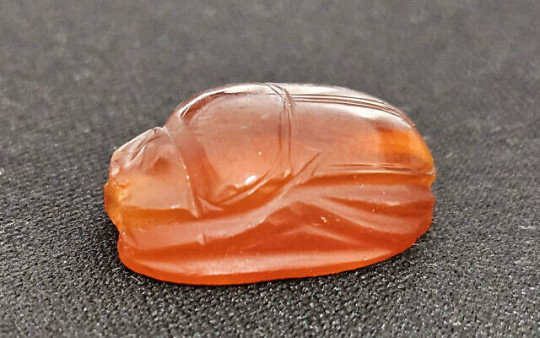

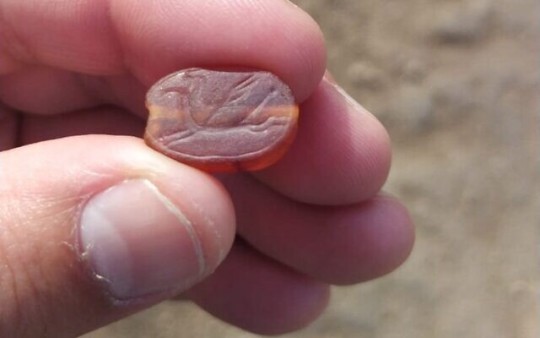
During the 6th-7th centuries BCE, “a large citadel stood at the top of the mount, where bathing facilities, halls and ritual chambers were found from the period of Assyrian rule. This rule, as we know, was responsible for the destruction of the Kingdom of Israel” in the First Temple period, IAA archaeologist Dr. Yitzhak Paz explained.
The scarab is likely from this period of Assyrian control and “may indicate the presence of Assyrian (or perhaps Babylonian) officials at Tel Rekhesh during this period,” Paz added. If the scarab can be conclusively dated and this connection proven, it will be a discovery of “great significance,” he said.
Scarab seals of a similar type, fashioned into a dung-beetle shape from a wide variety of stones, originated from Pharaonic Egyptian culture but were widely used throughout the ancient world.
The orange color and material of the scarab found by Abrahamov are fairly rare, the IAA said, as most were made from a softer bluish stone and then covered in glaze, which in almost all cases has worn away with time.
The IAA said it’s likely that the recent rains uncovered the scarab. “As in every winter, when the rainy season arrives, antiquities start to ‘float’ and rise to the surface,” IAA Director Eli Escusido said.
“I am imploring the public to obey the Antiquities Law, and request that if you come across an archaeological find, report it to the Antiquities Authority while in the field. The exact location where an object is found is extremely important… The special scarab will be stored in the state archive, where we can research and learn more about it,” he said.
Under Israeli law, any found man-made object dating from before 1700 is to be turned over to the authorities. Abrahamov received a good citizenship certificate for doing so.
By GAVRIEL FISKE.
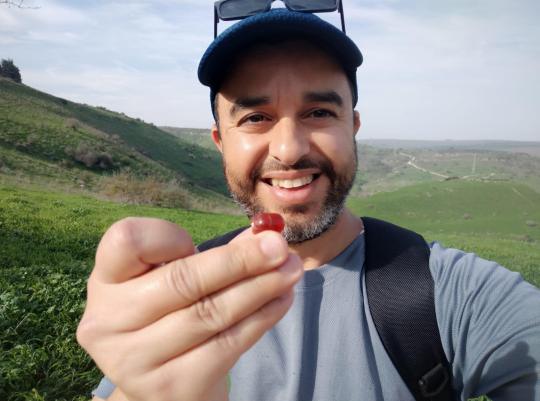
#A Rare 2800-Year-Old Scarab Amulet Found in Israel#Nahal Tabor Nature Reserve#First Temple period#carnelian stone#ancient artifacts#archeology#archeolgst#history#history news#ancient history#ancient culture#ancient civilizations#art#ancient art
81 notes
·
View notes
Text

Bead Net Mummy Shroud
Late Period, Dynasty 26 (664-525 BCE)
Artist:
Egyptian
The winged scarab beetle in the center of this beaded shroud invokes Khepri, the morning form of the sun god, whom ancient Egyptians depicted as a dung beetle. Just as the sun is born anew each dawn, Egyptians planned to be reborn into a new form of existence after death. As symbols of this renewal, scarab amulets were secured to the body with linen wrappings or incorporated into nets made of beads and laid over a mummified body. The image’s power is strengthened by the hieroglyphic meaning of the scarab shape, “to come into existence.”
AIC
333 notes
·
View notes
Text
Hell-o guy, gals, and non binary pals, this is your Cabin Crew Leader Thoth speaking! Welcome aboard this Flight of the Dead with Mwt Airlines! Thank you for your attention while I go through some important safety information for you!
In preparation for departure, be certain that your mummy is laid flat and your canopic jars are stowed. Make sure that your carry-on offerings are placed completely under the coffin in front of you. Portable shabtis are not approved for use inflight, however, you may use protective amulets when advised by your crew. Please direct your attention to Ammit in the cabin. For everyone’s safety, Osiris’ regulations require your compliance with all hieroglyphic signs and invocations, or Ammit is allowed to eat you before we serve inflight pA.t cake.
Please review the ‘How Not to Get Your Heart Eaten’ card in the seat pocket in front of you. It explains what a heart scarab is as well as the favourite bribe gifts of all the 42 Assessors of Maat. Your sarcophagus serves as an approved flotation device. To use it, pull up and take it with you to the nearest usable exit. After exiting the flight, place your arms through the straps and then hug coffin lid to your chest. As the flight attendants are pointing out, there are exits here, here and, here (Ammit at this point twists in classic ‘Walk like an Egyptian’ poses to demonstrate this).
Take a moment to locate the exit nearest you keeping in mind that the closest usable exit may be located behind you. If there is a loss of this flight’s divine power, don’t worry; you’re already dead so oxygen isn’t needed where you’re going! As a reminder, smoking is not permitted in any area of the aircraft because all of you are covered in very flammable materials. We don’t want a repeat of Tutankhamun do we! Finally, we ask you not to distract the duatlings with knives on the wings. If you upset a creature who’s dual wielding knives that is on you.
On behalf of Anubis, the incorporeal embodiment of Ma’at and your entire crew, it is our pleasure to have you aboard.
Enjoy your flight to Aaru!
#Please use caution when opening the overhead compartments and removing items#since someone’s organs may have shifted during flight.#god I'm so sorry I've no idea what possessed me to even write this#(tutankhamun thing is in reference to the time someone thought his body spontaneously combusted. He didn't but y'know)
322 notes
·
View notes
Text

Brooch of Ancient Egyptian Scarab in a Modern Winged Mount
Brooch featuring an ancient scarab in a modern winged mount, scarab is ancient Egyptian, (scarab). New Kingdom, ca. 1539-1077 BC; (gold mount) early 1900s, glazed steatite and gold (modern), Mrs. Kingsmill Marrs Collection, Worcester Art Museum, 1926.86
One of the most popular motifs among revivalist jewelers was the scarab. These small beetles were powerful amulets in their day and represented the power and mystery of ancient Egypt to 19th- and 20th-century travelers to the Middle East.
Read more
146 notes
·
View notes
Text

Ancient Egyptian faience amulet in the shape of a winged scarab. Artist unknown; ca. 1070-945 BCE (21st Dynasty, Third Intermediate Period). Now in the Metropolitan Museum of Art.
#art#art history#ancient art#Egypt#Ancient Egypt#Egyptian art#Ancient Egyptian art#Egyptian religion#Ancient Egyptian religion#kemetic#jewelry#jewellery#amulet#faience#scarab#21st Dynasty#Third Intermediate Period#Metropolitan Museum of Art
502 notes
·
View notes
Text


Pectoral with Scarab
Egyptian, ca. 1295-1069 BCE (New Kingdom, Dynasty 19-20)
The scarab-pectoral is a funerary amulet, which was originally attached to mummy wrappings. The amulet should assure the renewal of the deceased in the afterlife similar to that of the god Osiris, which is why the inscription, which names the seated god, is the same as the inscription, which identifies the worshipping deceased. The combination of sun-oval and dd-pillar of Osiris represents the unification of both deities, and of the cyclical and the linear aspects of time and eternity; the result is the renewal of both deities, of this and the other world, as well as the deceased. While the reverse of the pectoral focuses on the unification process, the front represents the renewal (scarab with baboons in the barque) and rising of the sun (winged sun disc). The amulet should guarantee the meeting of the deceased with the sun god and his consequential renewal.
It is striking that on both sides the scarab is lopsided; it seems to be unlikely that this was just a mistake of a less qualified artist. Most probably the lopsided placement has to do with the idea of the "sloping celestial path," which can be expressed by a lopsided sky hieroglyph. The motif of the scarab in the barque flanked by solar baboons is rare on private pectorals of the New Kingdom, and more popular on scarabs, or finger rings see.
26 notes
·
View notes
Text


scarabsolaris 🪲
a gender related to scarab beetles, their connection to the sun, and their symbolism of resurrection, renewal, and protection.
in ancient egypt, scarab beetles symbolized regeneration and rebirth. they were associated with the sun and with the gods Khepri, Atum, and Re. scarab imagery frequently appeared on carved amulets and official seals as symbols of protection and spiritual power. large scarabs, known as heart scarabs, were placed on the chest of the dead in order to aid them in the afterlife.
image ID: two images of a pride flag with 6 stripes. the outer two are a dark purple-blue, and the inside 4 are green, yellow, orange, and dark red in that order. the first flag has clip art of a scarab with outstretched wings holding a circle shape in its front legs. the second flag is just the stripes.
#my coins >:0#mogai#gender coining#xenogender#liom term#mogai coining#scarab gender#sun gender#mogai gender#liom gender#sungender
84 notes
·
View notes
Text
Sorry but if martyn keeps that scarab amulet, all i can imagine is him having tiny bird wings for the slowfalling and jump boost,.,.,,,
9 notes
·
View notes
Text
ok i want to talk about layla's costume as taweret's avatar
(disclaimer: i am not a scholar, what i know, i know because i studied it on my own, and while i do fact check most of my sources, i don't know everything - please take what i say with as grain of salt and not as absolute truth)
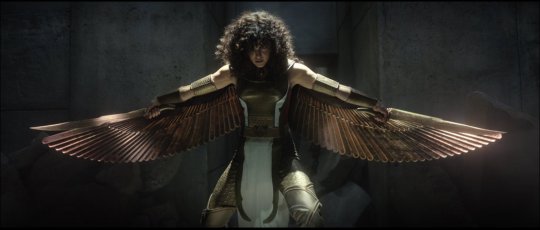
first of all: the wings.
now, taweret’s images don’t usually show wings - that’s a trait inherent to isis (ese or wusa). i wrote a little bit about taweret’s roles here and, much like her, isis is a goddess associated with protection and healing (including childbirth and protection of women). in the myths, her wings are symbol of that protection, and she uses them to breathe life back into her brother-husband osiris. so while she is not a goddess directly associated with death (like taweret), she is The figure connected to rebirth and restoration, and her sacred animal, a kestrel, is associated with funeral customs.
many depictions show her (and her sister nephthys/nebet-het) with wings attached to her arms, just like layla’s costume.
wings in general play a great role in egyptian mythos: a very ancient conception of the cosmos envisioned the Heavens as the enormous wings of the great falcon god horus. these wings, usually attached to the disk of the sun, were used as protective motif. you can see isis on steven’s sarcophagus in the asylum:
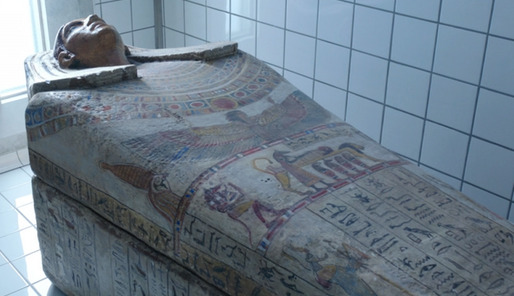
and the sun disk on jake’s:

now: the swords.
short swords weren’t considered a very powerful/useful weapon in ancient egypt, since they would’ve been made fully of bronze (handle included) and bronze is a very light, easily breakable material. however, there is a slight curve to layla’s swords, which seems to resemble a khopesh.


the handle, the dent, the slight curve of the front part of the blade and the inscription do kind of remind me of this. it’s obviously not the same, however i am convinced the khopesh was used as inspiration, given that even pharaohs were depicted as carrying one of these (and some have been found in royal graves: two in tutankhamon’s tomb).
third: the scarab on her chest.
scarabs were amulets and/or impression seals in ancient egypt. it was one of the (if not the) most popular amulets by the early middle kingdom. they were connected to the god khepri (one of the aspects of ra) who represented the rising sun and, to a certain extent, creation and renewal of life.
although scarabs were often placed in tombs, they were not part of any funerary rite we have record of. however, some amulets (which seems to be the one layla’s wearing), are funerary scarabs, called heart scarab, pectoral scarab and naturalistic scarabs (in order down below) that became part of the process of mummification.



layla’s seems to be inspired by a pectoral scarab, what with the colors and position.
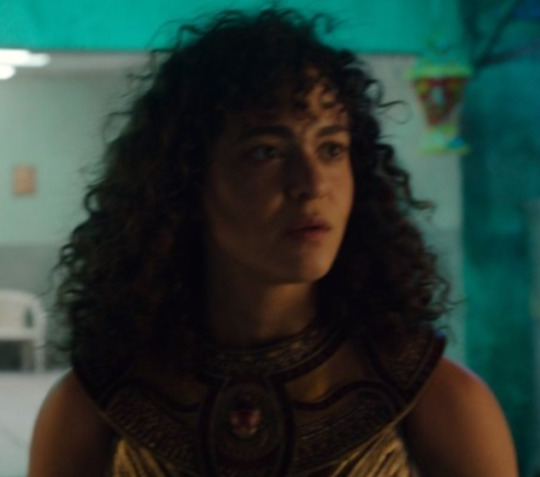

last but not least: the colors.
color was considered an integral part of an item's or person's nature, and each color had a meaning. layla’s palette includes reds (bronze), golds, whites and i believe the knee pieces have a little bit of silver + the pectoral might have a little bit of black or blue. colors were often paired and complemented each other: gold with silver, white with red, green with black.
the dominant colors are gold, white and red: gold represented the flesh of the gods and was used for anything which was considered eternal or indestructible. white was the color of purity, sacredness, cleanliness and simplicity. tools, sacred objects and even priest's sandals were white for this reason (and here i might go and analyze harrow’s dark sandals, but we’ll leave that for another time). red was primarily the color of chaos and disorder, the color of the desert, which was considered the opposite of the fertile black land; red was also the color of destructive fire and fury and was used to represent something dangerous; it was associated with the god of chaos, seth, and as chaos, red was considered the opposite to the color white; while red was the most potent of all colorst, it was also a color of life and protection: derived from the color of blood and the life-supporting power of fire, it was therefore commonly used for protective amulets.
the common theme here is protection. layla accepts to become taweret’s avatar to protect marc, steven and cairo. maybe i’m reading too much into it, but i think it says a lot about her character, and hers was the perfect arc during this season.
#moon knight#moon knight spoilers#ancient egypt#egyptian mythology#egyptian art#egyptian symbols#symbology#costume analysis#character analysis#layla el faouly#may calamawy#marc spector#steven grant#jake lockley#khonshu#khonsu#taweret#marvel moon knight#mcu moon knight#your local egyptian mythology nerd strikes once more#moon knight finale
30 notes
·
View notes
Photo

~Lifeforce Heart Scarab~ This Scarab Amulet was inspired by the ancient Egyptian heart scarab ritual amulets, in particular the heart scarab of Hatnefer. Handcut from gold, silver and brass with a diamond flower adorning it's back. It's wing cover is magnetically attached by gold plated neodymium magnets and can be detached to find a removable hidden gold Ankh inside, which represents eternal life. Ancient egyptians believed that consciousness resided in the heart so on the reverse side are hieroglyphs that respectively represent Ra/Sun energy, Mn/Game of life, Kepher/To make oneself, Ieb/Heart center of consciousness. These have been formulated as a spell that reads as: "The light of creation plays an enduring game of rebuilding itself from consciousness in the heart center." *available* Collaboration with @ifnotforgravity #scarab #jewelry #egyptianjewelry #diamond #handcut #handcrafted https://www.instagram.com/p/Ci5w0kmBQIG/?igshid=NGJjMDIxMWI=
2 notes
·
View notes
Photo

TN_Egyptologist[S] 1 point 1 year ago
Pottery; green glaze; brown discoloration; "King of Upper and Lower Egypt", incised on face; scarab with incised details on back; good condition; drilled.
The scarab was one of the most popular ancient Egyptian amulets. They were used as pieces of jewelry, commemorative items and seals, and magical amulets offering protection and good fortune. However, from the Middle Kingdom a specific type of scarab known as the Heart Scarab took on a very particular religious meaning and went on to become the most important amulet in the mummification and burial process.
The heart was seen as the home of the spirit, and the bodily element of the ancient Egyptian soul. In the Hall of Judgement, it was the heart which was weighed against the feather of Ma’at. If a person failed this test they would be devoured by Ammit, if they passed they would go on to enjoy a blissful afterlife. Unsurprisingly, the Egyptians were keen to protect their heart. The Heart Scarab was intended to protect the heart and act as a stand in for the heart of the deceased if it should be damaged.
The pragmatic ancient Egyptians also wanted to be sure that when they stood before Osiris and made the “Negative Confession”, their heart would not speak against them. The amulet was inscribed with Spells from the Book of the Dead, in particular Spell 30 which states:
O my heart which I had from my mother, O my heart which I had upon earth, do not rise up against me as a witness in the presence of the Lord of Things; do not speak against me concerning what I have done, do not bring up against me anything I have done in the presence of the Great God, Lord of the West (Osiris).
The earliest known scarab to have Spell 30 from the Book of the Dead is that of the thirteenth dynasty official Sobekhotep, and the earliest similar royal scarab is a beautiful gold and green jasper example made for the pharaoh Sobekemsaf II.
The amulet was usually carved in the shape of the scarab, representing the god Khepri who symbolised resurrection and rebirth. The heart scarab was also associated with mummification because the pupae of a scarab beetle resembles a mummy. The Egyptians also saw that the beetle would dig a shaft into the earth to bury its eggs, and the baby scarabs would later emerge from the earth. They associated this with the shaft leading into the burial chamber from which the reborn spirit would emerge.
The scarab was ideally formed from green or black stones, although examples in other colours have also been recovered. The silver scarab found in the Middle Kingdom tomb of Wah is of particular interest. Sometimes the scarab was set in gold, such as the green jasper and gold scarab of Hatnofer (father of Senenmut, New Kingdom) and the scarab of the pharaoh Sobekemsaf II. Occasionally, the amulet took the form of a human headed scarab, or a scarab with the head of another animal. Sometimes heart shaped amulets fulfilling the same function were inscribed with spell 30. From the late New Kingdom on, the scarab often had outstretched wings symbolizing the protection it offered.
New Kingdom 1550 - 1069 BC
MEDIUM/TECHNIQUE
Faience
DIMENSIONS
Legacy dimension: .014 Length: .011 W.
Boston Museum of Fine Arts
ACCESSION NUMBER
10.548
0 notes
Text
Scarab
That humble little beetle,Oft regarded as vermin,A shoveler of dung,But it’s a talisman,A pearlescent amulet,The god Khepri on Earth,An icon of regeneration,Carved of stone or faience or jasper,These creatures are the heavenly cycle,Day to night to sunrise,Life to death to rebirth,The inescapable truth,Indeed,Even within your funerary casket,You’ll still find a scarab,Sewed on to your chest,Wings…

View On WordPress
#animals#Creative Writing#Creativity#dark poetry#Fiction#history#human condition#human nature#humanity#mythology#poem#Poems#poetry#WorldofHarley#Writing
0 notes
Photo

Egyiptomi régiség
#hungariantattoos#tattoogirl#tattooart#tattoos#tattoo#tattooideas#egypt#egyptian#egyptiantattoo#necklace#necktattoo#ankh#anubis#bastet#gods#egyptiangods#scarab#amulet#wings#tatts#tattoomodel#tattoogirls#tetoválás#tetovalas#tetko#tetkó#tattoostyle#geryboytattoos#geryboytattoo#geryboy
2 notes
·
View notes
Photo

~ Winged scarab beetle amulet.
Place of origin: Egypt, Meydum
Period: Third Intermediate Period, 22nd Dynasty
Date: 945-712 B.C.
Medium: Electrum
#ancient#ancient egypt#winged scarab beetle amulet#third intermediate period#22nd dynasty#electrum#945 b.c.#712 b.c.
606 notes
·
View notes